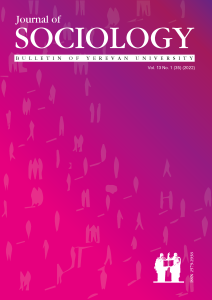Visual, Audial and Artistic Methods in Social Research
The Young People Creating Belonging Project
DOI:
https://doi.org/10.46991/BYSU:F/2022.13.1.039Keywords:
Qualitative methods, visual methods, sensory methods, belonging, young people in state careAbstract
This article reflects on the use of sensory and creative methods to explore feelings of belonging among young people in state care across Scotland. The concern was to understand how these young people, many of whom move frequently between short-lived placements in foster families and residential units, construct a sense of belonging in circumstances that differ considerably from conventional and often idealised notions of ‘home’. Sensory and creative methods, employed here within relatively unstructured interviews, proved invaluable to understanding difficult-to-articulate, ambivalent, emotional, and aesthetic aspects of belonging. Their use illustrates the potential of moving beyond a reliance on the verbal and textual in qualitative research. Notably this article demonstrates how the use of such methods in data collection and representation can highlight the significance of research participants’ agency and creativity however difficult their affective and financial circumstances. As such, these methods also facilitate a greater appreciation of the complex personhood of research participants who may otherwise ‘appear’ in research outputs only as exemplars of particular social problems.
References
Adams, M et al. (2007) ‘The 24-hour city: residents’ sensorial experience’ Senses and Society (Special Issue: The Senses and the City) 2(2): 201-217. doi.org/10.2752/174589307X203092
DeNora, T (2000) Music in Everyday Life. Cambridge: Cambridge University Press. ISBN: 9780511489433
Gordon, A (2008) Ghostly Matters: Haunting and the sociological imagination. London: University of Minnesota Press.
Klocker, N. (2007) ‘An Example of Thin Agency: child domestic workers in Tanzania’. In Panelli R
Punch S and Robson E. (eds.) Global Perspectives on Rural Childhood and Youth. ISBN 9780203942222
Mason J (2018) Affinities: Potent connections in personal life. Hoboken, NJ: Wiley. ISBN: 978-0-745-66463-7
May V (2011) ‘Self Belonging and Social Change’, Sociology, 45(3): 363-378. doi.org/10.1177/0038038511399624
Miller, D (2008) The Comfort of Things. Cambridge: Polity. ISBN
Pink, S (2009) Doing Sensory Ethnography. London: Sage.
Rivera Cusicanqui, S (2020) [2010] Ch’ixinakaz utxiwa: On decolonising practicecs and discourses (Critical South) Oxford: Polity Press.
Rose, G. (2007) Visual Methodologies. London: Sage.
Wilson, S., Houmøller, K., Bernays, S. (2012) ‘‘It just feels nice to go home to a nice home, and not, some house’: Taking account of the sensory construction of difficult family relationships in domestic spaces’ Children’s Geographies, 12(1): 101-113. doi.org/10.1080/14733285.2011.638172
Wilson, S. (2018) ‘Haunting and the knowing and showing of qualitative research’ The Sociological Review 66(6): 1209-1225. (published online 13/04/18 https://doi.org/10.1177/0038026118769843)
Yuval-Davis, N (2011) The Politics of Belonging: intersectional contestations. London: Sage.
Downloads
Published
How to Cite
Issue
Section
License
Copyright (c) 2022 Sarah Wilson, Elisabeth-Jane Milne

This work is licensed under a Creative Commons Attribution-NonCommercial 4.0 International License.








